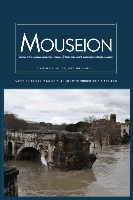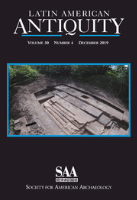
Anadolu Arastirmalari-Anatolian Research
Scope & Guideline
Innovating Insights into Archaeology and History
Introduction
Aims and Scopes
- Archaeological Research:
The journal emphasizes original archaeological findings from Anatolia, including excavation reports, artifact analyses, and site evaluations that provide insights into ancient civilizations. - Cultural and Historical Studies:
It covers studies on the cultural and historical significance of various artifacts, architectural practices, and societal structures within the context of Anatolia's diverse past. - Interdisciplinary Approaches:
The journal encourages interdisciplinary research that combines archaeology with other fields such as history, anthropology, and environmental studies to offer comprehensive perspectives on ancient Anatolian societies. - Typological and Chronological Analyses:
There is a consistent focus on the typology and chronology of archaeological materials, including ceramics, glyptic art, and architectural elements, contributing to the understanding of cultural development over time. - Ancient Religions and Rituals:
Explorations of ancient religious practices and beliefs, particularly in relation to purification and sanctity, are central themes, reflecting the significance of spirituality in ancient Anatolian cultures.
Trending and Emerging
- Environmental Archaeology:
There is a growing focus on environmental factors affecting ancient settlements, including studies on flood disasters and climate impacts, highlighting the importance of ecological contexts in understanding human history. - Technological Innovations in Archaeology:
Research incorporating advanced technologies such as microdebris analysis and multi-proxy approaches is on the rise, showcasing how modern methodologies are enhancing archaeological investigations. - Social Structures and Daily Life:
Emerging themes investigate social dynamics, including studies on local relations, cultural interactions, and daily life in ancient Anatolia, reflecting a broader interest in understanding human experiences. - Continuity and Change in Art Forms:
Investigations into the evolution of artistic expressions, such as glyptic art and pottery styles, are gaining traction, emphasizing the significance of art in cultural identity and historical continuity.
Declining or Waning
- Byzantine Studies:
The number of publications focusing specifically on Byzantine history and archaeology has decreased, suggesting a shift toward earlier periods of Anatolian history or other cultural contexts. - Hellenistic and Roman Era Focus:
Research centered on the Hellenistic and Roman periods appears to be less frequent, indicating a possible waning interest in these eras compared to earlier archaeological findings from the Bronze and Iron Ages. - Obituaries and Memorials:
The prevalence of obituaries and memorial articles has diminished, which may reflect a transition in editorial focus towards more research-driven contributions rather than commemorative pieces.
Similar Journals

Archaeological Reports-London
Illuminating Our Heritage, One Report at a TimeArchaeological Reports-London, published by Cambridge University Press, is a prominent journal dedicated to advancing the field of archaeology, encompassing a comprehensive range of studies that delve into the rich tapestry of human history from prehistory to modern times. With an ISSN of 0570-6084 and an E-ISSN of 2041-4102, this journal has been a significant source of scholarly articles since its inception in 1955, serving as a crucial platform for researchers and academics alike. The journal is categorized in the third quartile for Archaeology and Arts and Humanities, and holds a prestigious position in the first quartile for Classics, reflecting its vital role in the scholarly community. With its esteemed ranking of Rank #45/170 in Classics and Rank #210/413 in Archaeology, it provides unparalleled insights and findings that shape contemporary archaeological discourse. Although not an open-access publication, the journal remains key for those who seek to enrich their understanding of archaeological practices and heritage conservation. Engage with Archaeological Reports-London to explore cutting-edge research that illuminates our understanding of past civilizations and informs future directions in the field.

Mouseion-Journal of the Classical Association of Canada
Illuminating the echoes of the ancient world.Mouseion - Journal of the Classical Association of Canada, published by University of Toronto Press Inc, stands as a vital academic resource in the fields of Classics and Archaeology. With a focus on promoting scholarly discourse, this journal provides a platform for original research, critical reviews, and interdisciplinary studies that engage with ancient cultures and their legacies. Since its convergence in 2019, Mouseion has quickly established itself within the academic community, achieving a commendable Q1 ranking in Classics and Q2 in both Archaeology categories in 2023, showcasing its commitment to excellence. While not an open-access journal, it is positioned among the top 29% of classics journals, reflecting its impact and the quality of publications. Nestled within Canada, this journal addresses a global audience of researchers, professionals, and students dedicated to the exploration of the classical world, and it endeavors to contribute significantly to the scholarly understanding of cultural heritage.

Journal of Ancient History and Archaeology
Discovering the Rich Tapestry of HistoryJournal of Ancient History and Archaeology is a premier, open-access academic journal published by MEGA PUBLISHING HOUSE since 2014, dedicated to exploring the rich tapestry of ancient civilizations and archaeological discoveries. With ISSN 2360-266X, this journal has made significant strides in the field, achieving elevated rankings across multiple categories, including Q1 in Classics and Q2 in History as of 2023. Positioned in Romania, the journal serves an international audience of researchers, professionals, and students who seek to disseminate and access influential scholarship in ancient history and archaeology. As a prominent resource within the Scopus rankings, it reflects a robust commitment to advancing knowledge through quality research, making it a vital platform for the sharing and discussion of innovative ideas and methodologies. The journal covers a wide array of topics related to ancient societies, enhancing our understanding of their cultural, historical, and archaeological significance.

TRANSACTIONS OF THE ANCIENT MONUMENTS SOCIETY
Fostering Dialogue on Heritage and ConservationTRANSACTIONS OF THE ANCIENT MONUMENTS SOCIETY is a distinguished journal published by the Ancient Monuments Society in the United Kingdom, focusing on the rich interplay between architecture, conservation, and religious studies as they pertain to ancient monuments and heritage. With an ISSN of 0951-001X, this journal serves as an essential platform for researchers, professionals, and students interested in exploring methodologies, case studies, and theoretical perspectives that enhance our understanding of historical preservation and cultural significance. Although it has been classified in Q4 quartiles in prominent categories such as Architecture, Conservation, and Religious Studies, the journal plays a vital role in fostering scholarly dialogue in these areas. Access options and updates are available, making it easier for enthusiasts and experts alike to engage with ongoing discussions surrounding ancient monuments. Despite its discontinued coverage in Scopus, the journal remains an invaluable resource for those aiming to contribute to the conservation discourse and to understand the relevance of ancient sites in contemporary society.

Veleia
Connecting Scholars to Shape the Future of History and ArtVeleia is a distinguished academic journal published by the Universidad del País Vasco, specifically from the Department of History, Art, and Music. This journal serves as a vital platform for the dissemination of scholarly research in the fields of history and archaeology, with a particular focus on the cultural and historical narratives of the Basque region and beyond. With a commitment to academic rigor, Veleia facilitates the exchange of innovative ideas and methodologies among researchers, professionals, and students alike. Although currently not open access, the journal aims to contribute significantly to its field by promoting interdisciplinary dialogue and fostering a deeper understanding of historical contexts. By publishing high-quality, peer-reviewed articles, Veleia plays a crucial role in advancing the academic discourse surrounding history and the arts in contemporary scholarship.

Lanx-Journal of the Scuola di Specializzazione in Archeologia of the University of Milan
Connecting scholars to preserve our shared history.Lanx-Journal of the Scuola di Specializzazione in Archeologia of the University of Milan, published by Milano University Press, is a distinguished platform dedicated to the field of archaeology. Committed to advancing archaeological research and scholarship, this Open Access journal has been available to the global academic community since 2008, facilitating easy dissemination of innovative ideas and findings. With a strong emphasis on promoting interdisciplinary dialogue, the journal covers a wide range of topics from classical archaeology to contemporary practices, making it an invaluable resource for researchers, professionals, and students in the field. Situated in the historic city of Milan, it aims to contribute to the preservation and understanding of cultural heritage through rigorous academic inquiry and collaboration.

Bulletin of the American Society of Overseas Research
Championing impactful research in the realms of history and culture.Bulletin of the American Society of Overseas Research, published by the University of Chicago Press, serves as a premier platform for scholarly discourse in the fields of archaeology, cultural studies, and history. With its ISSN 2769-3600 and E-ISSN 2769-3589, this journal has swiftly established itself as a key resource for researchers, professionals, and students alike, demonstrating exceptional impact as evidenced by its Q1 rankings in multiple relevant categories for 2023. Notably, it holds the 93rd percentile rank in Arts and Humanities (History) and the 84th percentile in Social Sciences (Cultural Studies), evidencing its respected standing within the academic community. The journal's commitment to advancing knowledge and fostering interdisciplinary dialogue is complemented by its accessible publication from 2022 to 2024, making it an essential read for those engaged in the exploration of global cultural histories and archaeological research.

LATIN AMERICAN ANTIQUITY
Fostering Dialogue on Latin America's Historical NarrativeLATIN AMERICAN ANTIQUITY is a prestigious journal published by Cambridge University Press, focusing on the archaeology and history of Latin America. With an impressive impact factor reflecting its critical role in the academic community, this journal exemplifies excellence in research, landing in Q1 across multiple categories, including Archaeology and History, as per the 2023 category quartiles. The journal's scope covers a broad range of topics related to pre-Columbian cultures, ancient civilizations, and historical developments, making it essential reading for researchers, professionals, and students keen on exploring the rich tapestry of Latin American heritage. Although it is not an open-access publication, LATIN AMERICAN ANTIQUITY remains a vital resource for those dedicated to advancing knowledge in this dynamic field. With its commitment to scholarly rigor and a strong ranking in Scopus, it serves as a cornerstone for academic dialogue and investigation.

Vestnik Drevnei Istorii-Journal of Ancient History
Connecting Archaeology, Classics, and HistoryVestnik Drevnei Istorii - Journal of Ancient History, published by the esteemed Russian Academy of Sciences and the State Academy of Humanities (GAUGN), plays a pivotal role in the interdisciplinary field of ancient studies. Fostering scholarly discourse since 2016, this journal is positioned at the crossroads of archaeology, classics, history, and linguistics, as evidenced by its impressive 2023 ranking in multiple categories, including Q1 in Classics and Q2 in History. Although not open access, it serves as a critical resource for researchers, professionals, and students interested in deepening their understanding of ancient societies and cultures. With a reputation for rigor and a commitment to advancing knowledge, the journal aims to disseminate innovative research that sheds light on the complexities of ancient civilizations and their contributions to contemporary society. Current issues and a wealth of archived articles are available for exploration, fostering a rich environment for scholarly engagement.

PHOENIX-THE JOURNAL OF THE CLASSICAL ASSOCIATION OF CANADA
Unveiling the Legacy of Classical ThoughtPHOENIX - THE JOURNAL OF THE CLASSICAL ASSOCIATION OF CANADA is a distinguished academic journal published by the Classical Association of Canada, dedicated to advancing the study of classical antiquity and its enduring influence on contemporary society. With an ISSN of 0031-8299 and an E-ISSN of 1929-4883, PHOENIX serves as a pivotal platform for researchers, educators, and students in the field of classics. Although without open access provisions, the journal is noted for its rigorous peer-review process, ensuring the publication of high-quality scholarship that meets the academic community's standards. With its back issues archived since 2002, the journal is supported by a strong reputation, evidenced by its Scopus ranking in the 80th percentile in the Arts and Humanities - Classics category. Based in Toronto, Ontario, it continues to foster scholarly dialogue and exploration of themes ranging from ancient texts to contemporary interpretations of classical traditions. By prioritizing diverse contributions that enhance our understanding of classical studies, PHOENIX remains a vital resource for anyone engaged in the rich and varied exploration of the ancient world.